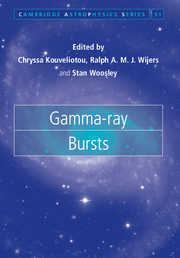Book contents
- Frontmatter
- Contents
- List of contributors
- Prologue
- 1 The discovery of the gamma-ray burst phenomenon
- 2 Instrumental principles
- 3 The BATSE era
- 4 The cosmological era
- 5 The Swift era
- 6 Discoveries enabled by multiwavelength afterglow observations of gamma-ray bursts
- 7 Prompt emission from gamma-ray bursts
- 8 Basic gamma-ray burst afterglows
- 9 The GRB–supernova connection
- 10 Models for gamma-ray burst progenitors and central engines
- 11 Jets and gamma-ray burst unification schemes
- 12 High-energy cosmic rays and neutrinos
- 13 Long gamma-ray burst host galaxies and their environments
- 14 Gamma-ray burst cosmology
- 15 Epilogue
- Indix
- Plate section
- References
1 - The discovery of the gamma-ray burst phenomenon
Published online by Cambridge University Press: 05 December 2012
- Frontmatter
- Contents
- List of contributors
- Prologue
- 1 The discovery of the gamma-ray burst phenomenon
- 2 Instrumental principles
- 3 The BATSE era
- 4 The cosmological era
- 5 The Swift era
- 6 Discoveries enabled by multiwavelength afterglow observations of gamma-ray bursts
- 7 Prompt emission from gamma-ray bursts
- 8 Basic gamma-ray burst afterglows
- 9 The GRB–supernova connection
- 10 Models for gamma-ray burst progenitors and central engines
- 11 Jets and gamma-ray burst unification schemes
- 12 High-energy cosmic rays and neutrinos
- 13 Long gamma-ray burst host galaxies and their environments
- 14 Gamma-ray burst cosmology
- 15 Epilogue
- Indix
- Plate section
- References
Summary
The Vela satellite system
A description of the discovery of gamma-ray bursts (GRBs) must necessarily begin with a description of the Ve l a Hotel satellite system, which, because of its unique apabilities, was responsible for the first confident detection of a GRB (see also Bonnell & Klebesadel (1996) for an earlier description of the discovery). In the course of international discussions toward a nuclear test ban treaty in the late 1950s it became apparent that clandestine nuclear tests could be performed beyond the Earth's atmosphere in order to avoid detection. Because of negotiations being conducted toward the treaty and concerns over the possibility of exoatmospheric testing, the Los Alamos National Laboratory (named the Los Alamos Scientific Laboratory at the time) was charged in 1959 with development of a satellite-borne system for the detection of nuclear devices detonated in space. In these early days of space experimentation the program provided planning for a total of five launches, each placing a pair of satellites in orbit, in order to assure success. The first of these launches was conducted in 1963. In fact, the program was successful beyond the most hopeful expectations, so much so that the spare hardware was assembled for a sixth launch, in 1970.
The satellites were launched in pairs and placed into a common circular orbit at a radius of 120 000 km. This orbit provided a very benign environment for instrumentation designed to detect the radiation signature of a nuclear detonation performed in the near vacuum of space.
- Type
- Chapter
- Information
- Gamma-ray Bursts , pp. 1 - 8Publisher: Cambridge University PressPrint publication year: 2012



